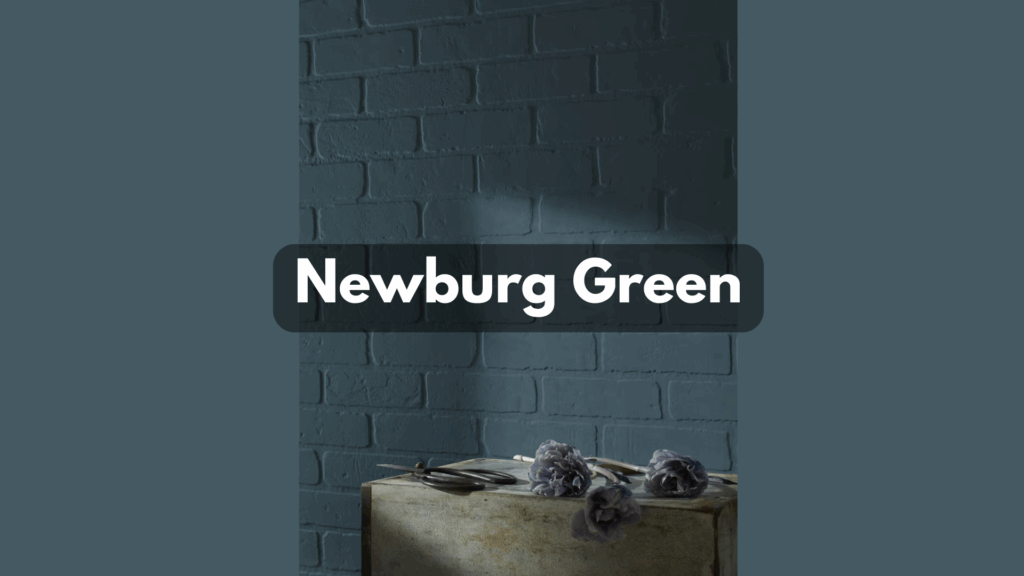Ever stared at paint swatches until your eyes crossed? I’ve been there, too.
In this blog, I’ll walk you through everything you need to know about Benjamin Moore’s Newburg Green (HC-158). Whether you’re painting a living room, bedroom, or kitchen, I’ll help you decide if this rich, historic color is right for your space.
I’ve tested this paint in different lighting conditions and paired it with various décor styles. After 15+ years of home renovations, I’ve learned what works and what doesn’t.
You’re looking for honest paint advice, not marketing hype. That’s exactly what you’ll get here. By the end of this review, you’ll understand:
- What makes Newburg Green unique
- How it looks in different rooms and lighting
- What colors complement it best
- Common mistakes to avoid
Let’s find out if this classic shade deserves a spot on your walls.
Why Newburg Green (HC-158) Is the Perfect Choice?

Newburg Green stands out in Benjamin Moore’s Historic Collection for a good reason. It’s a flexible, stylish shade that works in almost any room. No matter your design style, this color finds a way to fit in.
What makes it special is the balance it strikes. It’s rich and bold but not too strong. The mix of blue-green with soft gray undertones adds depth that shifts with the light.
This color feels timeless. Yet, it still works beautifully in modern homes. That means your space will look fresh now and still feel stylish years later.
Newburg Green also pairs well with both soft neutrals and bold accent shades. It looks great next to wood, metal, and natural textures. This makes it a smart choice if you want a unique color that still feels easy to live with.
The Rich Undertones of Newburg Green (HC-158)
Newburg Green (HC-158) is more layered than it first seems. Part of Benjamin Moore’s Historic Collection, it blends blue and green tones with a soft gray base. This balance gives it depth and flexibility.
One of the things that makes this color special is how it shifts throughout the day. In the morning, it leans more toward blue. In the afternoon, the green tones stand out. By evening, it becomes deeper and more dramatic.
Its richness comes from its perfect level of saturation. It’s bold enough to make a statement but soft enough to use throughout a room. It works well as either an accent or a main wall color.
Newburg Green also brings a touch of history and beauty. It connects with classic design yet still feels modern and fresh. That timeless mix is why designers continue to choose it again and again.
The Psychology of Newburg Green (HC-158)
Colors influence how we feel, and Newburg Green (HC-158) is no different. This balanced shade brings calm, comfort, and a sense of harmony to any room.
Green is linked to growth and nature, while the blue undertones add peace and calm. Together, they create a space that feels both fresh and restful.
Studies show green can ease eye strain and boost focus, making Newburg Green great for offices or reading corners. In bedrooms, it supports sleep and calm. Its gray undertones add maturity while still feeling playful with the right accents.
The historic roots give it a lasting, stable feel. In uncertain times, Newburg Green helps turn your space into a peaceful, grounded retreat.
Where Is Newburg Green (HC-158) Best Used in An Interior?
Newburg Green (HC-158) is a deep, rich shade that works well in a variety of interior spaces. Its mix of calm blue and grounding green makes it ideal for rooms where you want a touch of style and comfort.
The best places to use Newburg Green include:
- Home Libraries and Studies
- Dining Rooms
- Bedrooms
- Bathrooms
- Kitchen Cabinets
- Accent Walls
What kind of floors would look best with Newburg Green (HC-158)?
The right flooring can boost Newburg Green (HC-158) and bring out its full beauty. This rich shade pairs well with a wide range of floor materials, from classic hardwood to bold tile. Best flooring pairings for Newburg Green include:
- Medium to Dark Hardwood
- Light Hardwood
- Natural Stone (like limestone or slate)
- White Marble
- Neutral Carpeting (beige, taupe, or gray)
- Patterned Tile (vintage or Moroccan-inspired)
Top Color Combinations with Newburg Green (HC-158)
Finding the perfect color partners for Newburg Green can transform your space from ordinary to extraordinary. These carefully selected combinations enhance the beauty of Newburg Green while creating balanced, harmonious rooms.
1. Chantilly Lace (OC-65)

Chantilly Lace is a bright, clean white that pairs beautifully with the richness of Newburg Green. Its crisp finish adds contrast and helps balance the depth of the green.
Use it on trim, ceilings, or even surrounding walls to keep the room from feeling too dark. This pairing is perfect for creating a sharp, modern look while still feeling classic.
It works well in kitchens, living rooms, or hallways where you want to highlight architectural details. Together, they create a space that feels bright, stylish, and grounded.
2. Pale Oak (OC-20)

Pale Oak is a soft, warm neutral with just a touch of pink that complements the cool base of Newburg Green.
The pairing creates a wordly and gentle contrast. Use Pale Oak in nearby spaces, on upper walls, or to tone down bold features. It’s a great way to bring warmth into a room without clashing.
This combination works beautifully in bedrooms, living rooms, or open-plan homes where color flow matters. It feels cozy, refined, and approachable.
3. Edgecomb Gray (HC-173)

Edgecomb Gray is a timeless greige that fits effortlessly alongside Newburg Green. It’s warm, subtle, and doesn’t compete for attention, allowing the green to shine.
Use Edgecomb Gray in connecting rooms or across main walls for a soft, stylish backdrop. The pairing is ideal for homes with open layouts or neutral furniture.
It keeps spaces calm and cohesive while adding gentle depth. Edgecomb Gray brings warmth and comfort, making it perfect for everyday living areas.
4. Hale Navy (HC-154)

Hale Navy is a deep navy blue that brings rich contrast and depth when paired with Newburg Green. The colors together feel bold, dramatic, and full of character.
Use Hale Navy on built-ins, cabinets, or feature walls to create a grounded, stylish feel. This combination works especially well in home offices, dining rooms, or libraries.
It adds a sense of tradition while still feeling fresh. With soft lighting or brass accents, the result is cozy and stylish.
5. Simply White (OC-117)

Simply White is a soft, warm white with a hint of yellow that softens Newburg Green’s cool tones. It offers a clean, subtle contrast that brightens a space without feeling too stark.
Use it for trim, ceilings, or cabinetry to create a warm, welcoming vibe. This pairing is especially useful in kitchens, bathrooms, or sun-filled spaces.
Simply White helps keep rooms light while letting Newburg Green add depth. Together, they make a space feel bright, relaxed, and balanced.
6. Revere Pewter (HC-172)

Revere Pewter is a warm gray-beige that blends beautifully with Newburg Green. It brings softness and neutrality to spaces where green takes the lead.
Use Revere Pewter on walls with Newburg Green on accents like shelving, trim, or built-ins. This pairing adds quiet depth and comfort to rooms without too much contrast.
It works well in living rooms, dens, or master bedrooms. The mix is timeless, calm, and easy to decorate around.
7. Gettysburgh Gold (1064)

Gettysburgh Gold brings warmth and shine to the cool tones of Newburg Green. These metal finishes add luxury without feeling overwhelming.
Use them in hardware, lighting, or decorative pieces to add contrast and texture. This pairing works well in kitchens, bathrooms, and dining rooms, where a little polish makes a big difference.
The glow of brass against deep green is eye-catching and stylish. Together, they create a look that’s both rich and inviting.
8. Balboa Mist (OC-27)

Balboa Mist is a light gray with warm undertones that pairs beautifully with Newburg Green. It offers a gentle contrast that makes the green feel even more special.
Use Balboa Mist in rooms next to Newburg Green to create flow or on walls where you want softness with a touch of depth.
This combination works well in bedrooms, hallways, or reading nooks. The result is a calming, current look that still feels classic and grounded.
9. Black Satin (2131-10)

Black Satin is a deep, soft black that gives bold contrast to the richness of Newburg Green. Use it to define spaces with strong lines, such as window frames, doors, or accent furniture.
This pairing adds drama, structure, and style. It’s perfect for entryways, home offices, or formal living rooms where you want visual impact.
The green adds life, while Black Satin keeps the look bold and timeless. Together, they create a modern, upscale feel.
10. Cloud White (OC-130)

Cloud White is a creamy, warm white that softens the bold presence of Newburg Green. It’s ideal for trim, ceilings, and built-ins in rooms with darker wall colors.
The warm white keeps the space feeling light and approachable while still letting the green shine. This pairing works well in bedrooms, family rooms, and kitchens.
It’s great for homes that lean toward traditional or transitional in style. The combination feels balanced, welcoming, and easy to live with.
How to Incorporate Newburg Green (HC-158) Into Your Home Decor?
You don’t need to paint an entire room to enjoy Newburg Green. This rich, versatile shade can be added in simple, stylish ways.
Start with accents like pillows, vases, or artwork. These are easy to swap and let you test the color. Paint a furniture piece like a bookshelf or island for a bold, contained pop of color. Use it on built-ins or cabinets to add depth and highlight your decor.
In kitchens, it looks great on lower cabinets with lighter uppers and stone countertops. Try it on ceilings for a cozy, unique touch—especially in bedrooms or dining rooms.
Outside, it makes a bold yet timeless front door. Curtains, bedding, or upholstery in Newburg Green bring softness and tie the space together.
Newburg Green (HC-158) vs. Other Warm Neutrals: A Comparison
Newburg Green is technically a color, but its muted, deep tone allows it to act much like a neutral in many interiors. It brings a sense of richness and depth that blends easily with both bold and subtle palettes.
When choosing between this shade and more traditional neutrals or trending greens, understanding the differences in mood, tone, and style can help guide your decision.
| Color | How It Compares to Newburg Green |
|---|---|
| True Grays | Grays can feel cold or flat. Newburg Green offers depth, personality, and a warmer, richer backdrop. |
| Hale Navy | Navy feels formal and classic. Newburg Green is more relaxed and nature-inspired, with similar depth. |
| Sage Greens | Sage is lighter and more casual. Newburg Green has more weight and a polished, refined feel. |
| Olive Greens | Olive is trendy and earthy. Newburg Green feels more timeless and won’t go out of style quickly. |
| Saybrook Sage / Hancock Green | These historic greens are lighter and softer. Newburg Green has stronger depth and a dramatic edge. |
| Warm Taupes | Taupes are calm and safe. Newburg Green offers more color and mood while still feeling grounded. |
While many of these other options work well in the right setting, Newburg Green stands out for its balance of richness and flexibility. It offers timeless beauty, a touch of drama, and a grounded style that suits both traditional and modern spaces.
Conclusion
Is Newburg Green worth it? After living with this color for weeks, I think so. This shade brings depth without darkness. It shifts beautifully as daylight changes. Not many paints can do that.
Remember, though—test it first. What works in my space might look different in yours. While no paint is perfect, Newburg Green handles most challenges well:
- It hides small wall flaws
- It doesn’t fade quickly
- It plays nice with both modern and traditional décor
Still on the fence? Start small. Try it in a bathroom or on an accent wall. The best paint choice isn’t about trends or what designers say. It’s about what makes you feel at home when you walk through your door.
For me, Newburg Green does exactly that. It might just do the same for you.

